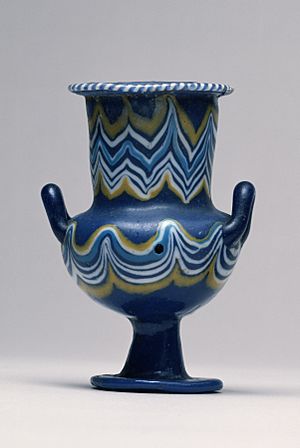Natron facts for kids

Natron is a natural mix of different salts. It mainly contains a type of sodium carbonate (often called soda ash) and about 17% sodium bicarbonate (also known as baking soda). It also has small amounts of regular salt and sodium sulfate.
When natron is pure, it is white or clear. But if it has other things mixed in, it can look gray or yellow. You can often find natron in salty lake beds that have dried up in very dry places. For thousands of years, people have used natron in many ways. Even today, the minerals that make up natron are used in many modern products.
In modern science, the word natron usually refers only to the main part of this historical salt, which is sodium carbonate decahydrate.
Contents
What's in a Name?
The English word natron comes from the French word natrón. This word traveled through Greek and originally came from the Ancient Egyptian word netjeri. Netjeri was the Egyptian name for natron.
You might notice that the chemical symbol for sodium is Na. This symbol comes from the New Latin name natrium, which was also inspired by the word natron.
How People Used Natron
Ancient Egyptians collected natron from dry lake beds. They used it for many things for thousands of years.
- Cleaning: Mixed with oil, natron was an early form of soap. It could make water softer and help remove oil and grease. It was also used as a toothpaste and an early mouthwash.
- Medicine: People mixed natron into early antiseptics to clean wounds and small cuts.
- Food Preservation: Natron was great for drying and preserving fish and meat, helping them last longer.
- Pest Control: It was even used as an old-fashioned bug killer in homes.
- Other Uses: Natron helped in making leather and was used to bleach (whiten) clothes.
Natron and Mummies
Natron was very important in Egyptian mummification. It could soak up water, acting as a drying agent. This helped to preserve bodies. Also, when natron got wet, it made the environment less friendly for bacteria, which helped keep the body from decaying. Some cultures also believed natron could keep both living and dead people spiritually safe.
Natron in Art and Craft
Ancient Egyptians added natron to castor oil. This made a special fuel that burned without smoke. This was very helpful for artists who painted inside ancient tombs, as it kept the tomb walls clean from soot.
Natron was also an ingredient for making a beautiful color called Egyptian blue. People like the Romans used it with sand and lime to make ceramics and glass. This continued until at least 640 CE. The mineral was also used as a flux to help melt and join precious metals together.
Why Natron Isn't Used as Much Today
Over time, many of natron's uses were replaced by other similar sodium compounds and minerals. For example, the cleaning power of natron is now mostly provided by soda ash (its main ingredient) and other chemicals. Soda ash also took natron's place in making glass. Many of the old household uses for natron are now handled by regular baking soda, which is another important part of natron.
What Natron Is Made Of
Natron is the mineral name for sodium carbonate decahydrate (Na2CO3·10H2O). This is the main part of the historical natron. This mineral is not very hard, with a Mohs hardness of 1. It usually forms crusts or coatings.
The term "hydrated sodium carbonate" can refer to a few different forms of sodium carbonate that contain water. However, in industry, it often means just the decahydrate form (the one with 10 water molecules). Both the hepta- and decahydrate forms can lose water in dry air, changing into a simpler form called monohydrate.
How Soda Ash is Made
Sodium carbonate decahydrate stays stable at normal room temperatures. But if the temperature goes above 32°C (90°F), it can change into a different crystal form. This process releases a clear, salty water with a little bit of a solid mineral called thermonatrite. You often find natron alongside other minerals like gypsum and calcite.
Most of the soda ash made by humans today is sodium carbonate anhydrate (Na2CO3). This is made by heating other sodium compounds, like sodium bicarbonate, at high temperatures (150 to 200°C).
Images for kids
See also
 In Spanish: Natrón para niños
In Spanish: Natrón para niños




